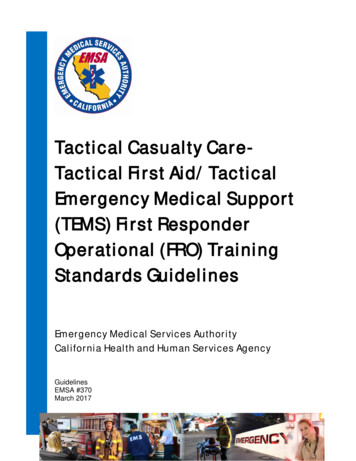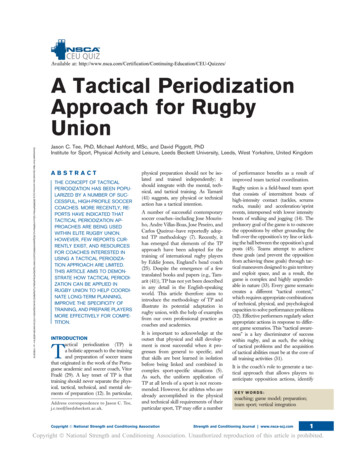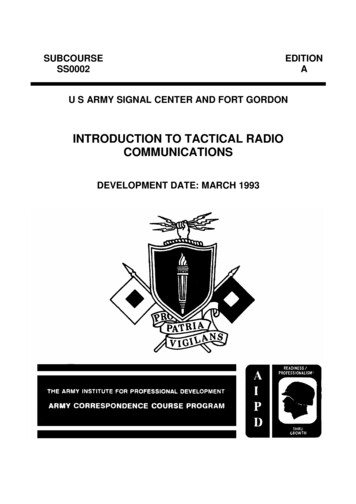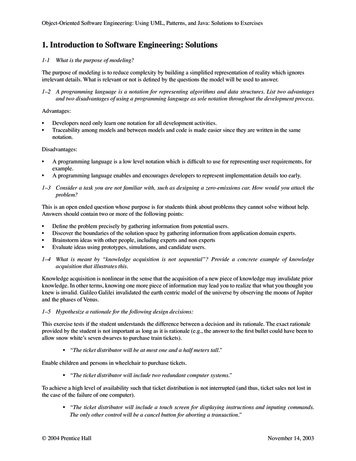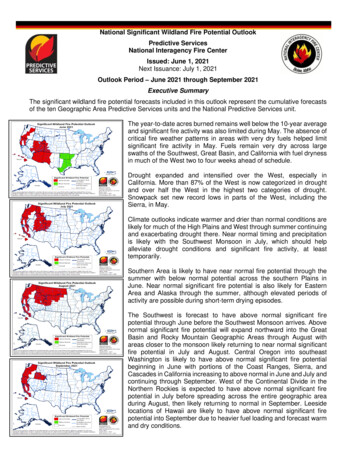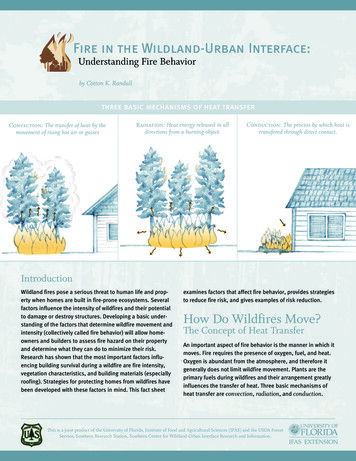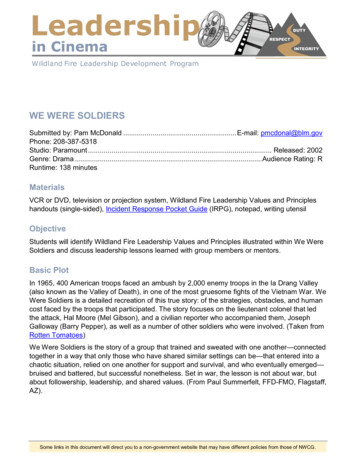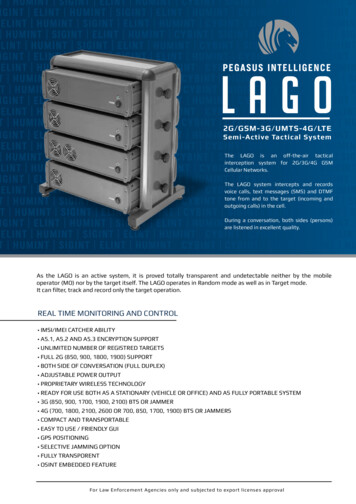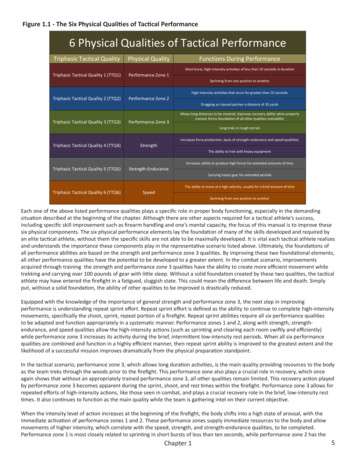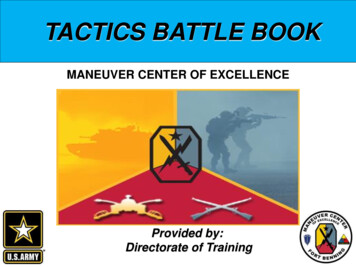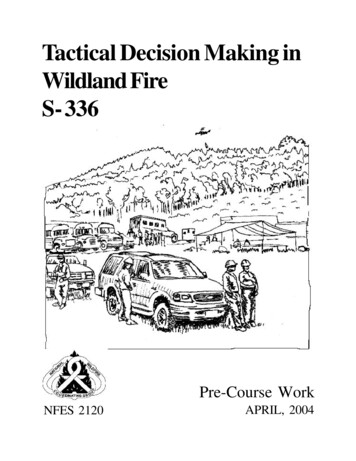
Transcription
Tactical Decision Making inWildland FireS- 336Pre-Course WorkNFES 2120APRIL, 2004
Tactical Decision Making inWildland FireS- 336Pre-Course WorkAPRIL, 2004NFES 2120Sponsored for NWCG publication by the NWCG Training Working Team. The use of trade, firm or corporation namesin this publication is for the information and convenience of the reader and does not constitue an endorsement bythe National Wildfire Coordinating Group of any product or service tot he exclusion of others that may be suitable.Comments regarding the content of this publication should be directed to:National Interagency Fire Center, National Fire Training Support Group, 3833 S. Development Ave., Boise, Idaho83705. E-mail: nwcg standards@nifc.blm.gov.Additional copies of this publication may be ordered from National Interagency Fire Center, ATTN: Great BasinCache Supply Office, 3833 South Development Avenue, Boise, Idaho 83705. Order NFES 2120.
Description of the Performance Based SystemThe NWCG Wildland and Prescribed Fire Qualifications System is a “performance-based”qualifications system. In this system, the primary criterion for qualification is individual performance asobserved by an evaluator using approved standards. This system differs from previous wildland firequalifications systems which have been “training based.” Training based systems use the completion oftraining courses or a passing score on an examination as primary criteria for qualification.A performance-based system has two advantages over a training based system: Qualification is based upon real performance, as measured on the job, versus perceivedperformance, as measured by an examination or classroom activities. Personnel who have learned skills from sources outside wildland fire suppression, suchas agency specific training programs or training and work in prescribed fire, structuralfire, law enforcement, search and rescue, etc., may not be required to complete specificcourses in order to qualify in a wildfire position.1.The components of the wildland fire qualifications system are as follows:a.Position Task Books (PTB) contain all critical tasks which are requiredto perform the job. PTBs have been designed in a format which willallow documentation of a trainee’s ability to perform each task.Successful completion of all tasks required of the position, asdetermined by an evaluator, will be the basis for recommendingcertification.IMPORTANT NOTE: Training requirements include completion of allrequired training courses prior to obtaining a PTB. Use of thesuggested training courses or job aids is recommended to prepare theemployee to perform in the position.2.b.Training courses and job aids provide the specific skills and knowledgerequired to perform tasks as prescribed in the PTB.c.Agency Certification is issued in the form of an incident qualificationcard certifying that the individual is qualified to perform in a specifiedposition.ResponsibilitiesThe local office is responsible for selecting trainees, proper use of task books,and certification of trainees. See Appendix A of the NWCG Wildland andPrescribed Fire Qualification System Guide, PMS 310-1, for furtherinformation.
PREFACEThe pre-course work for S-336 contains four parts. The first is a paper by JohnKrebs encouraging a return to the original format of the Standard FirefightingOrders. The second part discusses Recognition Primed Decision Making, anintrinsic skill employed by tacticians. The third part, Tactical EngagementPrinciples applies tactical doctrine employed by military organizations to wildlandfire. The fourth part, DRAW D, offers a tactical framework for wildland fireengagement decision making.In addition to the reading included above, students are expected to be thoroughlyfamiliar with the contents of the Wildland Fire Suppression Tactics Reference Guide(PMS 465, NFES 1256), and the human factors, communication and leadershipconcepts learned in prerequisite courses.The units in Wildland Fire Suppression Tactics, S-336 will expand upon the training,knowledge and experience you possess as a firefighter to enhance your ability as atactical leader. The course is not so much about what tactic to employ when,where, or why, as it is about how successful tactics are developed to accomplishstrategies and your role in processing the incident assignment.During the course exercises you will be expected to: Deliver and receive oral communication, as you would on an incident, eitherface to face or on the radio. Apply the concepts found in the pre-course work reading to tacticalscenarios, in particular the Standard Firefighting Orders and WatchoutSituations. Apply the Incident Response Pocket Guide and Fireline Handbook to tacticalscenarios. Apply the human factors, communication, leadership and tactical knowledgegained from previous courses. Participate, as either leader or follower, in developing and executingcommander’s intent in tactical scenarios.i
Please take time to add a few acronyms to your vocabulary. These may be new toyou, or you may have heard of them in previous courses. These acronyms derivefrom the Incident Response Pocket Guide and will be used throughout the course: SA Situational AwarenessRMP Risk Management ProcessYou are required to bring a current version Incident Response Pocket Guide andFireline Handbook to the course.You are encouraged to bring from your home unit examples of Size-up Reports and“incident organizer” forms (similar to the ICS-201 form) for use in courseexercises.ii
CONTENTSPREFACE . iPart 1 - Standard Firefighting Orders . 1Part 2 - RPD on the Fireground . 7Part 3 - Introduction to Tactical Engagement Principles .15Part 4 - Levels of Engagement and DRAW-D .37iii
iv
PART 1STANDARD FIREFIGHTING ORDERSThe following is quoted from a February 25, 2003 memorandum from the NationalWildfire Coordinating Group to the NWCG working teams.The original ten Standard Firefighting Orders were developed in 1957by a task force commissioned by the USDA-Forest Service ChiefRichard E. McArdle. The task force reviewed the records of 16tragedy fires that occurred from 1937 to 1956. The StandardFirefighting Orders were based in part on the successful “GeneralOrders” used by the United States Armed Forces.The Standard Firefighting Orders were organized in a deliberate andsequential way to be implemented systematically and applied to all firesituations. The reorganization of the Orders was undertaken in the late1980’s to form an acronym (“FIREORDERS”), thus changing theoriginal sequence and consequently, the intent of the orders as aprogram and logical hazard control system.Upon joint recommendation of the NWCG Training, Safety & Health,and Incident Operations Standards Working Teams, NWCG approvedthe restoration of the original ten Standard Firefighting Orders, withminor wording changes, at the May 22-23, 2002 meeting in Whitefish,Montana.We feel this change back to the original intent and format will improvefirefighters’ understanding and implementation of the ten StandardFirefighting Orders. Please ensure this information is passed on to allyour fire management personnel.Many fire managers noted over the last several years that firefighters of allqualifications were taking actions on fires that did not apply their fire behaviortraining and experience based on observing wildland fires. The following letterfrom Jim Steele and John Krebs provided the motivation to return to the originalStandard Firefighting Orders.1
Over the past several years our attention to safety paradigms has become more achecklist tool to measure our failures than to successfully guide firefighters througha safe assignment. We are continually told to pay attention to the fundamentals, yetour understanding of many fundamental tasks is poor to nonexistent. Rarely do wecheck to be certain firefighters understand standards and application of our widelyaccepted safety paradigms. When we have an opportunity to embrace a series ofsafety paradigms that exist with order and purpose, it is truly important that we fullyunderstand the reasons and purpose.Each geographic area has benefited from individuals that grew up in the professionwhen it was young, and the workforce relied on stand-up common sense and lotsof physical labor to be safe and successful. John Krebs, a Fire Behavior Analyst,and recently retired Fire Management Officer from the U.S. Forest Service,Clearwater National Forest, Idaho, is such a person in the Northern Rockies. Hehas for years helped us understand the application of the original StandardFirefighting Orders. I don’t think many of us fully understand the reasons behindthe sequence of these orders. John recently explained this process in a letter.My interest in fire behavior, particularly in relation to fireline safety, hasnot diminished with time. I’ve had an opportunity to stay involved infire with three fire assignments in 1996 and 1998, as well asparticipating in a couple of the National Fire Behavior workshops puton by the Region.Having just finished reading Maclean’s “Fire on the Mountain” I wasagain brought to tears at the tragic and senseless loss of those preciouslives. The 1994 National FBA workshop included a visit to MannGulch. As we sat overlooking those 13 crosses our thoughts were thatthis kind of event would not happen again because our knowledge offire behavior and our emphasis on training had greatly improved. Howwrong we were! Where have we failed to make fire behavior the mostimportant thought in the minds of our fire fighters when they areactually engaged in the suppression activity?2
Looking back to my first guard school training in 1958, I recall that the“10 STANDARD ORDERS” formed the framework for much of theteaching. The people who developed those original orders wereintimately acquainted with the dirt, grime, sweat and tears of actualfireline experience. Those orders were deliberately arranged accordingto their importance. They were logically grouped making them easy toremember.First and foremost of the Orders dealt with what the firefighters arethere to encounter “the fire.”1.2.3.Keep informed on fire weather conditions and forecasts.Know what your fire is doing at all times. Observe personally,use scouts.Base all action on current and expected behavior of the fire.Each of the ten Standard Orders are prefaced by the silent imperative“YOU,” meaning the on-the-ground firefighters the person who isputting her or his life on the line!!! My gut aches when I think of thelives that could have been spared, the injuries or close calls whichcould have been avoided, had these three Orders been routinely andregularly addressed prior to and during every fire assignment!As instructors and fire behavior analysts have we become so enthralledwith our computer knowledge and skills that we’ve failed to teach thebasics? One does not have to be a full-blown ‘gee whiz’ to applythese Orders – they revolve around elementary fuels-weathertopography. These are things that are measurable and observable,even to the first year firefighter.When we went out as a fire team and were ‘briefed,’ it was ourresponsibility to seek answers to basic questions – the first being,“What is the weather forecast?” Following that were questionsconcerning what the fire was doing, where it was expected to go andhow was it to be confined, contained, and/or controlled. Everyfirefighter is entitled to ask and receive answers to these same inquiries.I should re-word that every firefighter should be “required” to ask.”3
Logically following these three fire behavior related orders were threedealing with fireline safety:4.5.6.Have escape routes and make them known.Post a lookout when there is possible danger.Stay alert. Keep calm. Think clearly. Act decisively.One cannot know if an escape route or a safety zone is adequate untilthe Orders addressing fire behavior have been specifically evaluated.One of the primary functions of a lookout is observing and monitoringthe weather and fire behavior. How can it be that some of our mosthighly trained and experienced fire personnel can be on a fire such asSouth Canyon and not record even one, on-the-ground weatherobservation? Where did we as trainers go wrong? I have a nephewwho jumped out of McCall. Shortly after the South Canyon tragedy, Iasked him if he ever carried a belt weather kit. His answer shockedme, “Uncle John, we don’t have room for those things.” Please tell methat has changed . If humidities (reference Fire on the Mountains)were as low as 11% at 2400 hours on July 5, just what were they doingon the afternoon of July 6 on the western drainage? How can afirefighter possibly “Keep informed on fire weather conditions.”without on site monitoring of relative humidities, wind, etc.The next three 10 Standard Orders centered around organizationalcontrol:7.8.9.Give clear instructions and be sure they are understood.Maintain prompt communications with your men, your boss,and adjoining forces.Maintain control of your forces at all times.Again, if one hadn’t properly considered the first three fire behaviorrelated orders, it would be impossible to think that Orders 7, 8 and 9could be addressed with any validity.4
The last of the 10 Standard Orders is “Fight fire aggressively butprovide for safety first.” This is the only Order, which I would changejust slightly to “Fight fire aggressively having provided for safety first.”Read Maclean’s account (pg 65) concerning what should be the lastorder “as they chanted the ten basic fire orders in training, the firstorder ‘Fight fire aggressively, provide for safety first’ becomestransformed into ‘fight fire aggressively, provide for overtime first.’” Ican remember helping to teach some of the fire behavior (and related)courses in Missoula and asking the participants to write down all of theFire Orders they could recall. There were students in S-390 (andhigher) who could not recall more than 3 or 4 orders!! But, theyalways remembered, “Fight fire aggressively.”It was encouraging for me to learn from some first year firemen thatthey were required to learn the FIRE ORDERS in guard school. Myfear is that this was merely an exercise in rote memory, as Maclean’saccount would indicate. It’s something to chant but it is an exercisewithout memory.I urge you to re-establish the original 10 Standard Orders. They weredeveloped in a very special order of importance, grouped to makepractical sense and most importantly when considered prior to andduring every shift they will save lives. The 18 Situations that ShoutWatch Out; LCES; Look up, Look down, Look all around; etc. aremerely tools to reinforce the thought processes initiated by the original10 Standard Orders.If we diligently read and believe the compendium of fatality and shelter deploymentinvestigations, you will discover the commonality of failed tactics is, they wereimplemented without adequate attention to fire behavior and the effects of firebehavior.FIRE ORDERS is the sequence that was devised to assist firefighters to rememberthe original Standard Firefighting Orders. As John points out, the revised editionbecomes an “exercise in rote memory.” The original were designed as a decisionprocess that guided tactics and firefighter attention to fireline safety. The focus wasfire behavior.5
Please take the time to reconsider how you plan and implement tacticaldeployments, and how you manage fireline safety through risk assessment andmitigation. Use the original 10 Standard Orders, in sequence, as a decision makingprocess and verify the standards for each component: Is the weather forecastcurrent and applicable to where you are? Do you have current information on thefire, and can you get it? Are weather and fire predictions accurate – this part is notrocket science! Are escape routes located, timed, and trigger points establishedallowing for the travel times you know your people can travel? Are you certain yoursafety zone locations are known, sizes verified, and of effective size? Are yourlookouts able to see all of the area you want monitored during times you want? Areyour lookouts safe? Can your lookouts communicate, and do they know to whom,what to report and when? Do you feel confident you have enough information tosafely manage your resources against the fire? Is the radio your only means ofcommunication? Do you have the background to handle a situation of thiscomplexity; how comfortable do you feel right now?I share this with you because this is one of the first times I have heard the oftenused war cry, “back to the basics,” where the basics were explained.May 11, 2000Jim SteeleNorthern Rockies Training Center, Missoula, Montana6
PART 2RPD ON THE FIREGROUNDThe following article is reprinted withpermission from the April 1996American Fire Journal.Or say it’s your first day as a newbattalion chief. As you drive throughyour new district, you pass a refinery.You think: Wow, what if there were afire in a cat cracker on my very first shift!EXECUTIVE SUMMARYWe all like to believe we’d be cool, calmand capable in any emergency, but lackof experience may cause us to stumble.A recent study concluded that firegroundcommanders make pressure-baseddecisions in a most—untraditional way—and past experience is the key.Or how about the recent train/hazmatwreck in San Bernardino County, CA?Did anyone else out there say: It surewould have been exciting to be first-onon that one—would I have dazzled mypeers with some fancy footwork!The first-due company and battalionofficers that did respond to that incidentmay well have said: “Thank goodnessI’m on duty today!” Wouldn’t most ofus react that way? After all, we’re fullyprepared .aren’t we?RPD on the FiregroundHow to Avoid theBlank Screen SyndromeBy Larry C. Miller, Ops. Chief, Deputy,Los Angles County Fire Dept.Even new company officers or battalioncommanders usually feel that, since theyranked high on the list and were chosenover other qualified candidates, they mustbe more than ready to command anyemergency right?I recently took a weekend trip to SanDiego. As I passed the nuclear powerstation at San Onofre, I found myselfthinking: Wouldn’t it be something tobe first-in on a runaway reactor thatspreads from the containment buildingand digs a quarter-mile hole on its 8,000mile journey to China?It’s only natural that the first thing wewant as new company officers orbattalion commanders is to be tested sowe can prove to our peers, crews and,yes, even ourselves that we have beensent to earth by God as a gift tofirefighting.Yes, how cheated I would feel if I wasoff duty when the meltdown came. Cananyone identify with this?7
Sure, there are probably a lot of thingsthat we are gifted at when it comes tofirefighting. But I just mentioned nuclear,petro-chemical and hazmat control. Howabout multi-casualty incidents, highriseand wildland fires, structure collapse,flooding, swiftwater rescue, USAR, civildisturbance, air crash, shipboard fires,auto extrication, bio-chemical, EMS andplain old structure fires? And of course,there’s electrical—my personal favoriteis fighting something I can’t see.To some, this realization will take someof the pressure off. For others, it willpour it on. Only an honest selfassessment will determine which is thecase. Upon being promoted to companyofficer, almost everyone is scared todeath. If they aren’t, they should be.Believe it or not, the best companyofficers and battalion commanders areat least uncomfortable for their entirecareer! This shouldn’t be surprising,because there is plenty out there to beuncomfortable about.Honestly, does anyone reading this articletruly feel comfortable commanding anyone of these incidents, no matter howmany years of fire service experience theyhave? No way!Any one of the incidents listed at thebeginning of this article could happen onany night in nearly any district. So howcomfortable can anyone be with so muchto learn and so little time to learn it?The point is that no one feels comfortableabout everything the modern firefighteris responsible for knowing. The reasonfor this lack of confidence is thatfirefighting is not an inherited skill; it isnot inborn. Simply put, it is acquiredthrough experience.RECOGNITION-PRIMEDDECISION-MAKINGIn 1988, the U.S. Army Research Institutefor the Behavioral and Social Sciencescommissioned a study leading toTechnical Report 796 from KleinAssociates of Ohio. The objective of“Rapid Decision Making on the FireGround” was to understand how militaryofficers make decisions under extremetime pressures when lives and propertyhang in the balance.None of us is born with the skills to be afirefighter. They are all learned.Nonetheless, right from the first shift,most of use expect to perform as if it allcame naturally. One of the few benefitsof age—and the wisdom that sometimesaccompanies it—is the ability to lookback at where we came from and behonest in assessing the journey. It tookme 26 years to realize and admit this.Since, at that time, there had not been amajor conflict since Viet Nam, the Armywanted to know how they could best traintheir officers to make quick decisions8
under combat conditions. First, theyneeded to know how quick, effectivedecisions are made.incidents they had experienced before.Then they would act on this experienceby recognizing what to do without evenconsidering a second option.After Klein Associates reviewed thedifferent occupations that possibly sharedecision pressures, they found that(surprise!) fire service incidentcommanders face the same decisionpressure on a daily basis as a militarycombat officer.In other words, under time pressure,experienced officers produced a more“intuitive” approach to problem solving.However, few consistently selected oneparticular option of attack over others.Instead, they used a matching process—rather than calculation—to achieve adecision.The study went on to examineexperienced fire company officers inorder to determine just how they maderapid decisions. Dr, Klein, the founderof Klein Associates, derived from thesestudies what he thought was a radicalhypothesis: Experienced companyofficers did not use the conventionallaboratory or university model ofanalytical decision-making. This involvesreviewing all the pros and cons of manypossible solution to choose the correctcourse of action.When faced with extreme time pressure,the officers conjured up mental picturesinstead of words to compare the incidentat hand to a prototype or picture theyhad in their minds. When a memorypicture matched the incident (which thefirst picture did 80 percent of the time),they implemented the course of actionthat worked before.If the officer encountered an incident thatdidn’t match any previous experience,he would come up with a mental picturehe thought was closest to what he wasseeing. The officer would quickly playout the corresponding course of actionin his mind and, if it worked, he wouldgo with it. If not, he would mentally alterthe course of action, using a processcalled “mental stimulation, until theproblem was solved.Dr. Klein discovered that companyofficers faced with an emergency incidentusually didn’t have enough time tocompletely analyze all the possibleoptions. Instead, they invested what littletime they had on sizing up the situationrather than choosing among options ofwhat to do.Initially, Klein was surprised to find thatexperienced company officers did notselect from several options, but insteadidentified a situation as typical ofDr, Klein called this process“Recognition-Primed Decision,” makingor RPD. To understand it, think of the9
mind as holding a big slide carousel.New slides are placed in this carouselby experience, whether real or created.These slides/experiences can be drawnfrom later.have the slides in our carousel to dealwith these incidents.So, when the new guy pulls up to thatfirst fire and stumbles, he or she shouldn’tfeel bad—the slide carousel is probablynot fully developed yet. This alsoexplains why a great wildland IC maystumble at a highrise incident. His slidecarousel is whirling through a panoplyof wildland slides, but there’s an emptysection labeled “Highrise.”As a basic example, say a companyofficer gave an order to go to the truckand get the gas-powered smoke ejector.The crew member who received theorder instantly calls up a picture of whatthe smoke ejector looks like. Despitethe array of various equipment on thetruck, he has no problem fetching thepiece of equipment that resembles thepicture he has in his mind. It also helpsthat, on the way to the truck, he picturedwhich compartment the ejector was into reduce the hunt.Returning from our first room–and–contents fire as a new company officer,most of us realized that things could havegone a whole lot better. And most of usmade some decisions differently at thenext fire.Obviously, even this simple slide picturewas not there from birth, but put therethrough experience. This is the samemental process that goes on whenresponding to an emergency that willrequire tactical decision-making. Themind projects a slide picture of theclosest experience to the presentincident.Our minds can also change the slidecarousel, so we can compare the lastincident to the next similar incident andtake action based on the experiencegained. When the same type of fireoccurs again, the slide carousel presentsthe similar picture—and the course ofaction that will be successful. Hence theterm “Recognition-Primed Decision.”What all of this tells us is that we maynot know how to handle all the incidentslisted in the beginning of this article. It isnot surprising that we may beuncomfortable attacking a fire in anuclear reactor, a petroleum cat crackerfire or even a train derailment withhazardous materials. We simply may notIt takes skill to recognize situations astypical, and correctly using theprototypes or slide pictures is enhancedby experience. The ability to know if“X” applies is dependent on situationalawareness, i.e., experience.It is never enough to simply teach rulesto a novice and expect to make him or10
her an expert. For example, a sign that aroof is near failure is often described tonew firefighters as a “spongy” feeling.So the first time they set foot onlightweight, panelized roof, most rookiesthink it’s about to fail. New officers may make “cheat sheets”or command boards to help with earlysize-up and decision-making, but asexperience is gained, the cheat sheets areconsulted less and less.In fact, what they’re feeling is the typicalbounce of a good roof assembly. It willtake many walks on many different typesof roof assemblies and possibly manyfires under an experienced companyofficer to supply the critical cuesappropriate to roof-collapse to the newfirefighter’s carousel.The experienced officer makes the sizeup in a more intuitive way, without muchactive thought. If you ask theexperienced officer to recite the list ofwhat factors he/she considered, theofficer will take longer to express themthan a rookie will. This is because theexperienced officer observes the fire andcompares it to the slides in the mentalcarousel. When a match is found, he orshe gives the correct, time-tested orders.CRITICAL CUESCritical cues are the signs and symptomsthat help with a correct diagnosis.Examples of critical cues are those thingsthat company and battalion officersevaluate in an initial size-up, such as: Signs of structural failureWater supplyThis is not meant to disparage the use ofcheat sheets or command boards. Theycan serve as useful reminders of itemsthat may otherwise be overlooked or actas an assist on incidents that are notcommon in the district—where the slidelibrary may be a little weak.Life hazardsSpecial population (elderly,disabled, prisoners)Smoke (color, amount, location)Fire (color, amount, location,duration)Structure (house, factory, office,vehicle)Construction (age, composition)WeatherTime of dayResources (available, needed,special needs)Product involvedIn conjunction with the previousstatement that the experienced officer mayhave trouble articulating the steps in his/her decision-making process, let merelate a personal example.I was a paramedic for 12 of my 26 yearsin the fire service. I responded to dozensof full arrests, and my carousel is prettyfull of relevant slides. But when it comes11
time to pass the CPR exam, I have to goback and study all the “dance steps,”because the raters are more interested inthe exact process I use than theoutcome!So many improvements in our art canbe missed if firefighters aren’t given thelatitude to experiment with new ways ofdoing things. Crews that are held to rigidstep-by-step procedures for performinga tactical objective on the drillground maynot take the initiative to overcomefireground problems that weren’tcovered in the drill manual.Also, the exam process very seldomresembles the sight, sounds andcircumstances of a real incident.Therefore, the slides in my carousel don’trelate particularly well to a hypotheticalsituation.FILLING THE CAROUSELThere are many worthwhile trainingmethods that will help load the slidecarousel with pertinent pictures.Examples include hands-on training andlive-fire recreations where ideal actionsare practiced.Most of us are frustrated by the annualchanges to CPR procedures after somenew doc decides that “X” number ofventilations prior to starting CPR arebetter than whatever last year’s numberwas. And let’s not forget thoseconstantly changing compression rates.Are these process changes really betterfor the outcome of the patient, or arethey just designed to throw our carouselsout of whack?Another good idea is to
Tactical Decision Making in Wildland Fire S-336 Pre-Course Work APRIL, 2004. Sponsored for NWCG publication by the NWCG Training Working Team. The use of trade, firm or corporation names . Position Task Books (PTB) contain all critical tasks which are required to perfor
